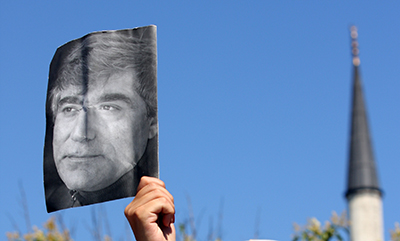A decision last week in the murder case of Hrant Dink will lead to a retrial, but Dink’s supporters are still not satisfied. The ruling on May 15 by Turkey’s Supreme Court of Appeals in Ankara acknowledged that there was a criminal conspiracy to murder the ethnic Armenian journalist, but stopped short of opening the way to a deeper investigation into potential involvement by Turkey’s powerful institutions.
The Supreme Court reviewed a verdict by an Istanbul court, passed on January 17, 2012, which was heavily criticized for failing to recognize Dink’s murder as an organized and deliberately planned crime, or that state agents bore responsibility, at a minimum, for neglecting threats against the journalist prior to his murder.
Dink, founder and former chief editor of the weekly newspaper Agos, was murdered in front of his Istanbul office in January 2007. The suspects were quickly arrested and put on trial, but the journalist’s family and friends–as well as human rights defenders–believed the masterminds were protected by the state. Dink had received threats for a long time before he was killed, and he had publicized those threats through his columns. Hate mail and threatening calls to Agos were part of the newspaper’s daily routine.
Supporters of the journalist from the independent Hrant Dink’s Friends Platform repeatedly pointed to evidence that government officials, police, military personnel, and members of the National Intelligence Agency (MIT) had played roles in the murder–at least, by neglecting their duty to protect the journalist. Evidence presented in court showed that more than one intelligence unit had been aware of the planning stage of Dink’s murder but had done nothing to prevent it. The defense also pointed out the triggerman and his immediate associates were not sophisticated enough to organize the professional hit that was Dink’s assassination.
On Wednesday, while the Supreme Court acknowledged the existence of a “criminal organization” behind the murder, it failed to recognize that an “armed terrorist” group was responsible for masterminding it. The distinction between the two formulations is crucial in Turkey’s law; the latter provides ground for the prosecution to treat the crime as a conspiracy that could involve government officials. The former essentially downgrades the murder to the stature of a regular crime. The investigation is therefore exempt from going beyond the immediate killers of Hrant Dink to seeking the commissioners of the murder among power structures.
The date for the retrial is yet to be determined. The details of the Supreme Court ruling are as follows:
Ogün Samast, the convicted triggerman who had confessed to the murder, had received 22 years and 10 months in prison (a relatively lighter sentence since he was not an adult on the day of the murder and was tried by a juvenile court in Istanbul) on July 25, 2011. The Supreme Court upheld this sentence.
A second defendant, Yasin Hayal, who had confessed to arming Samast and instructing him to kill Dink, had received the punishment of life without the possibility of parole. The Supreme Court upheld this sentence but demanded that Hayal also be tried for founding and leading the criminal organization behind Dink’s murder.
Back in January 2012, a third suspect, Osman Hayal (Yasin’s brother), was tried and acquitted of aiding the conspiracy to murder Dink. The Supreme Court overturned his acquittal, saying that the investigation into his alleged involvement had been insufficient. Dink’s defense team claims that Osman Hayal was with Samast on the day of the murder, based on security camera records.
Also in January 2012, a fourth suspect, Erhan Tuncel, a police informant accused of involvement in the conspiracy to murder Dink, was acquitted of the charge of being a leader of the armed terrorist organization behind Dink’s assassination. With the Supreme Court of Appeals’ ruling that no such organization existed, Tuncel will be retried on the lesser charge of being a member of a criminal organization.
Three other defendants will be retried on similar charges as Tuncel.
Dink family lawyer Fethiye Çetin told CPJ that justice cannot reach the masterminds of the murder when the perpetrators are classified as a “criminal organization” rather than an “armed terrorist organization.” Any group of persons that join together for the purpose of committing even a petty crime may be considered a criminal organization under the Turkish legal system, Çetin said. The term “terrorist organization” would invoke a different set of legal articles that would allow the investigation to go deeper–or, in this case, higher.
The Hrant Dink murder was “committed by an extremely well organized and professional organization,” Çetin said. The planning before, during, and after the murder, including removal of the evidence from the scene, shows that this was not the work of just another fanatical nationalist who one day decided to kill a public figure, Çetin said, and the investigation must go further to catch the culprits.
